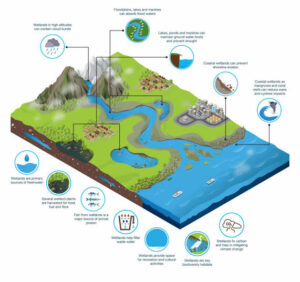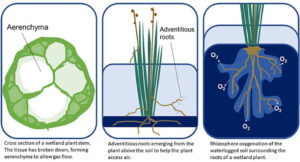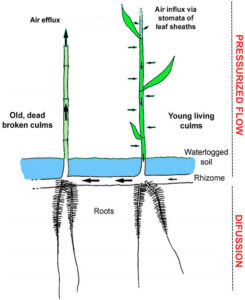Back to: Botany 300 Level
Hello, dear Afrilearn scholar! How are you today? I hope you’re feeling energetic and ready for another exciting lesson! We’ve already learned how important wetlands are for our world, but now, we’re going to focus on something really fascinating—the adaptations of plants in wetland environments. These plants have some of the coolest survival tricks up their sleeves, and today, we’ll dive into how they’ve evolved to live in such unique conditions.
Wetlands are environments with periods of flooding and waterlogged soils, so plants that grow there face some serious challenges, like low oxygen, high water levels, and the need to deal with salt or fresh water. But don’t worry; plants in wetlands have specialised features that allow them to thrive in these tough conditions. Ready to learn? Let’s go!
Adaptations of plants in wetland environments
What Are Wetlands?
As a quick reminder, wetlands are areas where water is near the surface of the soil for long periods. They can be freshwater (like marshes and swamps) or saltwater (like mangroves), and they’re full of unique plants that have special adaptations. These plants must survive in environments that can be either flooded or waterlogged for a long time, with either low oxygen levels or high levels of salt in the water. Now, let’s look at how plants have adapted to these conditions.

Adaptations of Plants in Wetland Environments
1. Aerenchyma Tissue (Air Spaces in Roots and Stems)
One of the major challenges plants face in wetlands is the lack of oxygen in the soil, especially when the land is flooded. However, many wetland plants have aerenchyma tissue, which are special air spaces in their roots and stems. This tissue allows them to transport oxygen from the air down to their submerged roots, helping them survive in waterlogged conditions.
Example: The water lily (Nymphaea) has large air spaces in its leaves and stems, which help it stay afloat on the water’s surface and allow oxygen to travel down to the submerged roots.
2. Adventitious Roots
In wetlands, the water can completely submerge the soil, so adventitious roots—roots that grow from areas other than the root system—are a key adaptation. These roots grow from the stem or other parts of the plant and can reach above the water to absorb oxygen, helping the plant breathe in flooded conditions.
Example: The mangrove tree has prop roots that grow above the water level, helping the tree stay anchored in the soft, wet soil while absorbing air. This allows the tree to thrive in salty, coastal wetlands.
3. Floating Leaves and Stems
Many wetland plants, especially in freshwater wetlands, have developed floating leaves and stems to stay above the water surface. These plants have air-filled spaces in their tissues, allowing them to stay afloat and capture sunlight for photosynthesis.
Example: The water hyacinth (Eichhornia crassipes) has large, thick leaves that float on the surface of the water. The plant’s roots hang in the water, helping it absorb nutrients while keeping the leaves exposed to the sun.
4. Salt Tolerance (Halophytes)
Plants that live in salty wetlands, like mangroves, have adapted to survive in salty conditions by becoming halophytes. These plants have special mechanisms to deal with excess salt, either by excreting salt through their leaves or by storing the salt in their tissues to prevent it from interfering with the plant’s internal processes.

Example: The mangrove tree has salt glands on its leaves that excrete excess salt, preventing the tree from becoming harmed by the high salt levels in coastal wetlands.
5. Flexible Stem Structures
Wetland plants are often exposed to strong winds and water currents. To cope with this, many have flexible stems that can bend with the movement of the water. This helps the plants avoid being uprooted or damaged by strong forces.
Example: The cattail (Typha) has long, flexible stems that allow it to sway with the current, preventing it from breaking in turbulent water conditions.
6. Root Modifications for Oxygen Intake
In wetlands, roots need oxygen, but sometimes the soil is waterlogged and has very little oxygen. Some wetland plants have specialised root systems that allow them to take in oxygen from the air, like the snorkel roots of the mangrove or the pneumatophores of the black mangrove. These roots grow upward out of the soil to get oxygen directly from the air.
Example: The black mangrove (Avicennia) has pneumatophores—small, peg-like roots that grow above the water’s surface and help the plant absorb oxygen in waterlogged soils.
7. Water Storage Structures
Some plants in wetlands have adapted to store excess water. These plants can store water in their stems or roots, allowing them to survive during dry periods or when water levels fluctuate in the wetland.
Example: The water lily stores water in its large, thick stems and roots, allowing it to survive in fluctuating water levels. The plant can also store excess nutrients in its leaves to use later when conditions are drier.
Why Are These Adaptations Important?
The adaptations we’ve discussed are crucial for helping wetland plants survive and thrive in challenging environments. Without these adaptations, these plants would not be able to survive in flooded soils, salty waters, or areas with limited oxygen. These adaptations help wetland plants do the following:

Access nutrients and oxygen in flooded soils.
Float and stay exposed to sunlight for photosynthesis.
Survive in saline environments by removing or storing salt.
Prevent erosion by stabilising wetland soils with their roots.
Provide shelter and food for wildlife by maintaining a healthy ecosystem.
Summary
In wetland environments, plants have evolved specialised adaptations to help them survive in flooded, salty, or waterlogged conditions. Some of the key adaptations include:
Aerenchyma tissue for oxygen transport.
Adventitious roots for access to oxygen.
Floating leaves to capture sunlight.
Salt tolerance mechanisms in mangroves and halophytes.
Flexible stems to resist strong water currents.
Pneumatophores or snorkel roots for oxygen intake in waterlogged soils.
Water storage structures to survive in fluctuating water levels.
These adaptations help wetland plants maintain their important roles in the environment, providing habitat for animals, purifying water, and stabilising the ecosystem. Without these plants, wetlands would be less productive, and the balance of the ecosystem would be disrupted.
Evaluation
- What is aerenchyma tissue, and why is it important for wetland plants?
- How do adventitious roots help wetland plants survive?
- Explain how mangroves adapt to salty water.
- Why do some wetland plants have flexible stems?
- How do water storage structures help plants in wetlands cope with changing water levels?
You did a fantastic job today! Understanding how plants in wetland environments have adapted to their surroundings shows you just how resilient and ingenious nature can be. Keep this curiosity going—you’re on your way to becoming an ecology expert! I can’t wait to see you in our next lesson. Keep up the great work, and stay inspired to keep learning!
